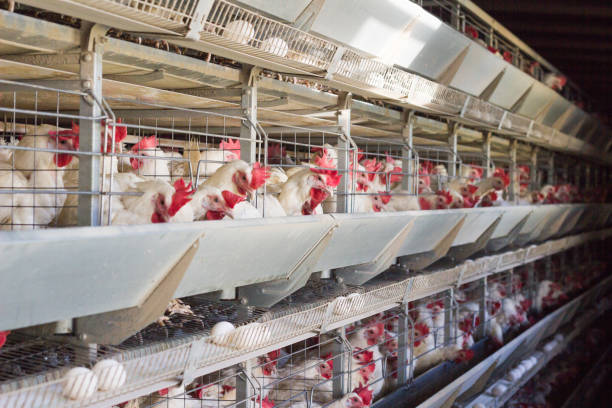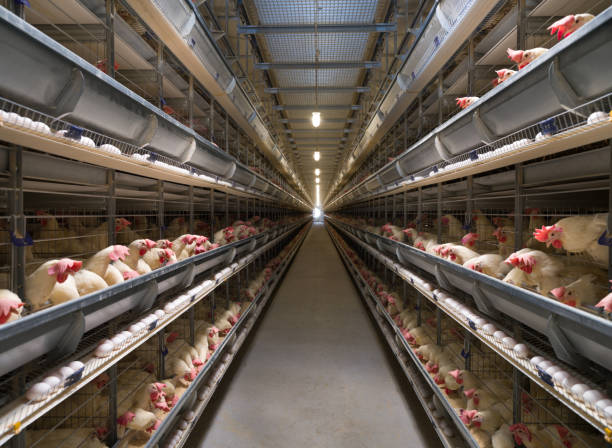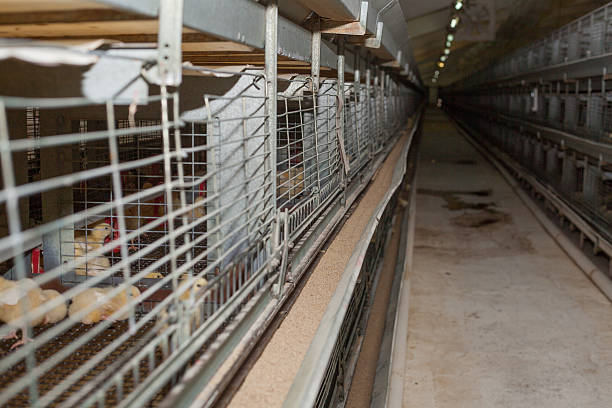
Optimize Your Poultry Operation with a 30000 Broiler Chicken Cage System
Optimize Your Poultry Operation with a 30,000 Broiler Chicken Cage System
In modern poultry farming, efficiency, productivity, and animal welfare are no longer mutually exclusive. They’re intertwined goals that require smart planning, innovative technology, and the right equipment. For large-scale broiler producers aiming to meet growing market demands, investing in a 30,000 broiler chicken cage system can be a game-changer. Whether you’re expanding an existing operation or starting a new commercial poultry farm, this high-capacity setup can significantly boost your performance, control costs, and ensure better bird health — all of which contribute to higher profitability.
What Is a 30,000 Broiler Chicken Cage System?
A 30,000 broiler chicken cage system is a large-scale, fully integrated housing solution designed for raising broiler chickens in a controlled, space-efficient environment. It typically includes multi-tiered cage structures, automated feeding and watering systems, manure removal mechanisms, ventilation controls, and lighting systems — all designed to enhance bird growth rates, reduce labor costs, and maintain biosecurity.
These systems are especially advantageous when compared to traditional floor-rearing methods. With rising land prices, environmental concerns, and the need for higher biosecurity standards, more and more producers are turning to cage systems for their broiler operations.
But is such a large setup suitable for your farm? The answer depends on your production goals, farm size, resources, and long-term vision. Let’s explore some of the key benefits and considerations to help you make an informed decision.
Increased Capacity with Efficient Space Utilization
One of the most striking benefits of a 30,000 broiler chicken cage system is its ability to rear a large number of chickens in a relatively small area. Unlike conventional floor systems, where chickens are raised in single-tiered barns, cage systems utilize vertical space through multiple levels. This tiered design can drastically increase the number of birds per square meter without compromising animal comfort.
For instance, a typical floor barn might house around 15 birds per square meter, whereas a well-designed cage system can accommodate up to 35–40 birds per square meter, depending on local regulations and management practices. This means you can raise 30,000 birds in less than half the space required by traditional methods.
Moreover, vertical farming with cage systems allows better access to equipment and easier monitoring of bird health and behavior. This optimized space usage also translates into fewer buildings or a more compact facility, which reduces construction and heating/cooling costs.
Improved Biosecurity and Disease Control

Biosecurity is a top priority in modern broiler farming, especially with the increasing global threat of avian diseases like avian flu. The cage system offers a naturally superior environment for disease prevention thanks to its elevated design and limited bird-to-ground contact.
Because the chickens are off the floor, the risk of picking up pathogens from feces or contaminated litter is greatly reduced. Additionally, many cage systems include automatic manure removal, which further limits the build-up of waste and potential disease vectors.
With automated feeding and water systems, there’s also less human interaction required, minimizing the chances of cross-contamination between batches or sections of the flock. These features contribute to a substantial reduction in disease incidence, better flock uniformity, and a lower need for antibiotics — a huge plus in today’s health-conscious market.
Cost Savings and Labor Efficiency
Labor is one of the biggest operational expenses in broiler farming. The 30,000 broiler chicken cage system significantly reduces the amount of manual labor required. Thanks to automated systems for feeding, watering, manure removal, and climate control, one worker can manage thousands of birds with ease.
For example, a farm using a manual system would require several workers to fill feeders, monitor water lines, clean litter, and remove manure by hand. With a cage system, these tasks become fully automated. Feed is delivered directly to each cage row, ensuring every bird gets consistent nutrition, while water lines maintain optimal hydration automatically.
The system’s centralized control also allows for precise environmental management. With smart ventilation and lighting control, farmers can maintain optimal temperatures, humidity levels, and light cycles to promote faster growth and better feed conversion ratios (FCR).
What this means is that you can run a larger farm with fewer employees or use the same staff to handle more birds — a major cost advantage.
Consistent Performance and Growth Monitoring
With a large flock, individual bird health can be difficult to monitor in traditional systems. Cage setups allow for much better visibility and access, making it easier to spot sick or underperforming birds early. In some advanced setups, farmers can even implement RFID tagging or automated weight tracking to monitor growth trends in real time.
Uniformity in growth is crucial for maximizing profit. Chickens that develop at different rates can lead to complications at processing, where size disparities can slow down production and reduce market value. Cage systems promote more consistent feeding and environmental conditions, which in turn produce more uniform batches.
In addition, by optimizing conditions such as temperature, lighting, and feeding schedules, broiler chickens in cage systems often achieve market weight faster. This can shorten the grow-out period by several days, allowing more production cycles per year.
Sustainability and Environmental Considerations
As pressure grows from governments, consumers, and environmental groups to reduce agriculture’s environmental impact, the cage system provides a more sustainable alternative to traditional broiler farming.
By reducing land usage, minimizing waste accumulation, and improving resource utilization (like feed and water), cage systems lower the overall ecological footprint of broiler production. Many systems also collect manure in dry form, which can be used as organic fertilizer or processed into renewable energy, contributing to a circular economy model.
Another environmental benefit lies in the reduced need for heating and cooling. Since cages are tiered and airflow is easier to control, farms using cage systems can manage ventilation more efficiently than floor systems, especially in larger operations where energy use can be a major cost component.
Design Flexibility and Customization
Not all 30,000 broiler chicken cage systems are the same. Modern manufacturers offer a wide range of configurations to suit different breeds, market conditions, regulatory standards, and regional climates. Whether you’re looking for a four-tier A-frame design or a more traditional three-tier system, the right setup can be tailored to your specific needs.
Customization also extends to the level of automation. Some systems offer full AI-driven monitoring and adjustments, while others provide more manual operation with room for future upgrades. Depending on your budget and technical capacity, you can choose a system that scales with your business.
For example, if you’re setting up operations in an area with limited electricity access, a semi-automatic system might be a practical starting point, with plans to integrate full automation as your infrastructure improves. Or, if you’re targeting high-efficiency output for international markets, you might go for a fully integrated system with environmental sensors and data analytics.
Integration with Farm Management Systems
Data is the new currency in modern agriculture. Leading broiler cage systems come with smart integration capabilities, allowing farmers to monitor and control their entire operation from a mobile device or computer. This includes real-time temperature readings, feeding schedules, mortality rates, and environmental settings.
Such integration not only makes management more efficient but also allows for predictive maintenance and early issue detection. If a ventilation unit starts to underperform or a water line becomes blocked, these systems can send alerts to your device, letting you address the problem before it affects your flock.

Additionally, many systems offer historical data tracking, giving you insights into seasonal trends, productivity patterns, and potential areas for improvement. This data-driven approach leads to more informed decision-making, helping you optimize every aspect of your operation.
Choosing the Right Supplier and Support
No matter how advanced the system is, its long-term success depends on choosing the right supplier and after-sales support. When investing in a 30,000 broiler chicken cage system, look for a supplier that offers:
High-quality materials (such as galvanized steel to prevent rust and long-term corrosion)
Custom design options
On-site installation support or detailed manuals
Maintenance and repair services
Training for farm staff
A reliable supplier doesn’t just sell you equipment — they become a partner in your operation’s growth.
Producers in many countries have successfully scaled their operations by partnering with global poultry equipment providers like Livi Machinery, who specialize in large-scale, intelligent broiler cage systems. These companies not only understand the technical side of poultry production but also offer tailored solutions based on local requirements, breed preferences, and climate conditions.

What to Expect During Installation and Operation
Installing a 30,000 broiler chicken cage system is a significant undertaking, but with the right planning, it can proceed smoothly. Most large systems arrive in modular form, allowing for relatively quick assembly if you have proper infrastructure (like a well-designed poultry house and utilities in place).
The installation timeline typically ranges from a few weeks to a couple of months, depending on the complexity of the system and whether you’re starting from scratch or retrofitting an existing facility.
Before installation, it’s essential to ensure that your building meets the structural requirements for a multi-tier cage system — especially weight distribution and access to utilities. Once the system is installed, staff training should cover operation of each subsystem, from feeding lines to manure removal.
On the operational side, running a large cage facility doesn’t mean just turning switches and letting automation take over. It requires skilled management to ensure that all systems work harmoniously and that any issues are addressed promptly.
Overcoming Challenges and Building a Strong Team
As with any large-scale transition, adopting a high-density broiler cage system comes with its learning curve. Farmers may initially struggle with:
Monitoring such a massive flock effectively
Managing sudden equipment failures
Maintaining consistent environmental conditions across tiers
To overcome these challenges, it’s crucial to invest in training and build a skilled team that can operate and maintain the system.
Partnering with an experienced supplier can provide access to training materials, technical support, and troubleshooting guidance. Regular maintenance schedules and having backup power and spare parts can also help minimize operational disruptions.
Final Thoughts: Is a 30,000 Broiler Chicken Cage System Right for You?
If you’re running a large-scale commercial broiler operation — or if you’re looking to scale — the answer is most likely yes. A 30,000 broiler chicken cage system offers a future-proof, efficient, and profitable solution that aligns with today’s evolving poultry farming demands.
This system empowers farmers to produce more birds with less land, better biosecurity, and improved resource efficiency. It supports sustainable practices, reduces labor needs, and enables smarter, data-driven decision-making.
Of course, success doesn’t come from the equipment alone. It requires thoughtful planning, a skilled team, and a reliable partner. But when combined with the right support, a modern cage system can help your business thrive in a competitive and dynamic market.
Whether you’re operating in Asia, Africa, South America, or anywhere else, upgrading to a 30,000 broiler chicken cage system could be the strategic move that turns your farm into an industry leader.
